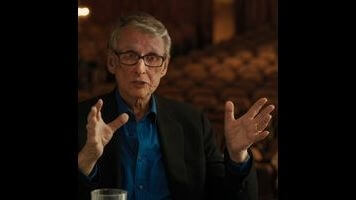Becoming Mike Nichols gets the job done. It finds a spine to Nichols’ directing, and it creates a desire to revisit his entire filmography. The movie itself isn’t much, a hands-off documentary that’s mainly a filmed stage performance, the performance being Nichols’ final interview over two nights and the stage being the site of An Evening With Mike Nichols And Elaine May. The first night is something like a dress rehearsal without an audience, and the second night takes place in a packed house. Whatever the reasons for this arrangement, it produces routinely clumsy editing in the finished film. Nichols’ friend and fellow director Jack O’Brien asks a few guiding questions, but Nichols seems to know where they’re going. He tells all the right stories about how he developed from a drowning improv student to an EGOT winner. He’s funny and candid and generous. Becoming Mike Nichols is a charming enough evening, a little over an hour of a New Hollywood legend regaling an audience with stories. The problem is it got scooped.
Three weeks before Becoming Mike Nichols, PBS launched the 30th season of American Masters with a biography of Nichols, this one directed by his comedy partner Elaine May, and it’s better in almost every way. It’s chronological, whereas Becoming awkwardly doubles back on Nichols’ childhood at one point. Nichols tells some of the same stories, like how a Hitler speech interrupted his passage out of Nazi Germany in 1939, often with the same wording. American Masters supplements Nichols’ contributions by including interviews with collaborators like Neil Simon and Meryl Streep, while Becoming sticks with the man himself. And Becoming is focused on the becoming, so it culminates with Nichols finally cracking his approach to directing on The Graduate, which earned him an Oscar for best director. But American Masters keeps going past the two big Nichols classics, covering less trampled ground like Carnal Knowledge, Silkwood, and Angels In America.
The narrower focus of Becoming Mike Nichols has the virtue of finding a narrative throughline to Nichols’ maturation. Over and over again, Nichols keeps learning the same lesson but in different contexts: Spontaneity is key. He learns it first as an actor performing improv with May, recognizing that he thrives on the expectation of the audience and the lack of a safety net. He learns it later as a theater director, giving himself a tight deadline to try his hand at his first play, Neil Simon’s Barefoot In The Park. He learns it again as a director on his first film, Who’s Afraid Of Virginia Woolf?, making discoveries about major scenes only once they’re being performed in front of him. And it finally clicks at the end of The Graduate, in a classic sequence that came as an epiphany on set. Nichols is an artist who has to live in the moment to get to the unconscious truth.
It’s a point made even more vivid by extended clips of Nichols’ work. A Richard Burton monologue takes on a feeling of great fortune after Nichols describes how hard it was to crack. The Simon & Garfunkel soundtrack of The Graduate is kismet through and through: Nichols happened to be listening to “The Sound Of Silence” while making the movie, and the readymade “Here’s To You, Mrs. Roosevelt,” simply needed a name change. The way Nichols tells it, there’s always a moment on a project where everything snaps into place. Sometimes that’s Nichols and his team trying to be as honest as possible in their storytelling. Other times it’s random chance, like Nichols happening to catch Robert Redford on Playhouse 90 or Dustin Hoffman off-Broadway and immediately recognizing their talents.
That’s the other great charm of Becoming Mike Nichols: The man loves actors. He’s floored by Marlon Brando and Jessica Tandy during the first run of A Streetcar Named Desire. Art Carney’s “a saint,” and Anthony Perkins gave him a crash course in camerawork. The most moving section is the first, where Nichols’ abiding love for Elaine May saturates the interview. In American Masters, Nichols gets explicit about his aversion to auteurism, specifically his respect for more literary and theatrical films and his refusal to take all the credit for a collaborative process. He’s more restrained about it in Becoming Mike Nichols, but it’s there in his appreciation of actors and acting, his reliance on faces and bodies to carry the meaning, and his preference for directors whose movies are as well known for their scripts and performances as for their men in charge, like those of Elia Kazan and Billy Wilder.
Kazan and Wilder are both deemed “less than meets the eye” by Andrew Sarris in The American Cinema. In the same book, Sarris says of Nichols, “His is the cinema and theatre of complicity.” For Sarris, Nichols’ work is impersonal. Nichols sees strength in that. Becoming Mike Nichols ends—except for an animation of his playbills and movie posters since 1967—with him sharing the credit in his Oscar speech for The Graduate: “It’s a picture made by a group.” Not that auteur theory would deny that, but Becoming Mike Nichols sees the director as a man with deep improv roots. A scene lives or dies by its collaborators—all of them.

